第三讲代词、介词、连词、冠词
2022版高考英语一轮复习语法专项突破专题三不可忽视的小词_代词冠词和介词短语第三讲介词短语学案含解
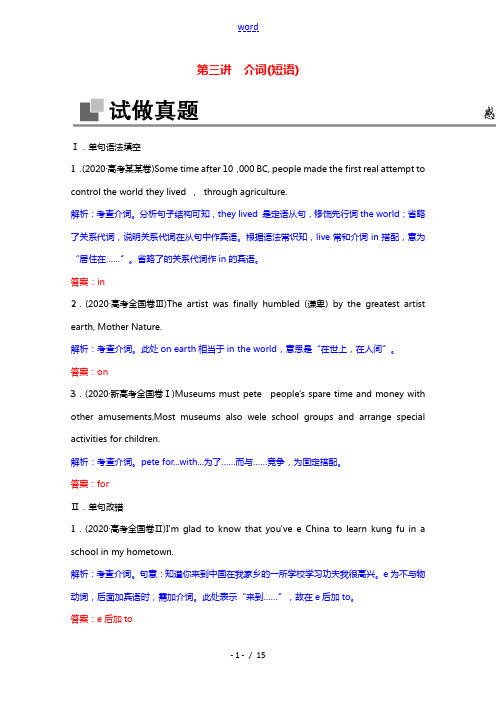
第三讲介词(短语)Ⅰ.单句语法填空1.(2020·高考某某卷)Some time after 10,000 BC, people made the first real attempt to control the world they lived ,through agriculture.解析:考查介词。
分析句子结构可知,they lived 是定语从句,修饰先行词the world;省略了关系代词,说明关系代词在从句中作宾语。
根据语法常识知,live常和介词in搭配,意为“居住在……〞。
省略了的关系代词作in的宾语。
答案:in2.(2020·高考全国卷Ⅲ)The artist was finally humbled (谦卑) by the greatest artist earth, Mother Nature.解析:考查介词。
此处on earth相当于in the world,意思是“在世上,在人间〞。
答案:on3.(2020·新高考全国卷Ⅰ)Museums must pete people's spare time and money with other amusements.Most museums also wele school groups and arrange special activities for children.解析:考查介词。
pete for...with...为了……而与……竞争,为固定搭配。
答案:forⅡ.单句改错1.(2020·高考全国卷Ⅱ)I'm glad to know that you've e China to learn kung fu in a school in my hometown.解析:考查介词。
句意:知道你来到中国在我家乡的一所学校学习功夫我很高兴。
e为不与物动词,后面加宾语时,需加介词。
英语之中名词 代词 动词 形容词 冠词 数词 副词 介词 连词 感叹词

(一)1、名词名词(Nouns)是词性的一种,也是实词的一种,是指待人、物、事、时、地、情感、概念等实体或抽象事物的词。
名词可以独立成句。
在短语或句子中通常可以用代词来替代。
2、代词是代替名词的一种词类。
大多数代词具有名词和形容词的功能。
英语中的代词,按其意义、特征及在句中的作用分为:人称代词、物主代词、指示代词、自身代词、相互代词、疑问代词、关系代词和不定代词八种。
3、动词,就是用来形容或表示各类动作的词汇。
基本上每个完整的子句都有一个动词,要表示第二个动作时可使用不定词、动名词、对等连接词、从属连接词或增加子句等方法连结。
根据其在句中的功能,动词可分为四类。
4、形容词形容词【adjective】很多语言中均有的主要词类中的一种。
主要用来修饰名词的词,表示事物的特征5、冠词的定义冠词是置于名词之前,对名词起限制作用的一种虚词。
冠词可以说是名词的一种标志,它不能离开名词而独立存在。
冠词的分类冠词分为不定冠词"a,an"、定冠词"the"和零冠词三种6、数词表示"多少"和"第几"的词,叫数词。
其用法相当于名词或者形容词。
数词分为基数词和序数词两种。
表示数目多少或顺序多少的词叫数词,数词分为基数词和序数词。
7、副词(Adverb)副词的定义: 副词是一种用来修饰动词,形容词,副词或全句的词,说明时间,地点,程度,方式等概念。
8、介词的定义和特征介词是一种用来表示词与词, 词与句之间的关系的词。
在句中不能单独作句字成分。
介词后面一般有名词代词或相当于名词的其他词类,短语或从句作它的宾语。
(二)1、名词,人或事物的名称3、代词,代替名词或者数词(比如some就是代替数目)3、动词,动作或状态4、数词,表示数目或顺序(比如序数词,5th就是表示顺序)5、形容词,人或事物的性质或状态(因为形容词一般修饰名词)6、副词,动作的特征或性状特征(因为副词一般修饰动词或形容词)7、冠词,表示名词的泛指或特指8、介词,表示名词或代词与其他词的关系(因为介词后面一半紧跟名词,代词或其他名词性结构)9、连词,连接词与词,短语与短语,句子与句子10、感叹词,表示说话时的感情或语气(三)1、adj. / a. 形容词用来描述一类物质的性质,状态,外貌,或人的性格特点,性质,品格如:big,happy2、adv. / ad. 副词用来修饰动作或形容词,一般在句子中做状语用表示动作的进行怎样,或表示程度,特点,如:clearly,happily3、prep. 介词连接地点,时间的一类词语,可以表示方位,时间.跟一些表示时间,地点的词连用表示介词词组如:in,to,on,under4、conj. 连词用来连接时间,地点,原因,结果的一类词语如:when,beacuse,so5、num. 数词表示数字的词,既可以是基数词,也可以是序数词如:one,two,first6、int. 感叹词表示感叹的一类词,一般不加一解释,只代表感叹如:what,how,haurray7、vt. 及物动词(后面要加宾语)行为动作的词如:do,finish,play8、vi. 不及物动词(后面不加宾语)表示行为动作的词如:appear9、n. 名词表示物体,物质的词如:pig,cow,man10、pron. 代词代指一类人,事或物的词如:he,she,hers,his,things11、art = 冠词,article的缩写(四)在英语语法中主要把词分为8大类:1.名词:表示人、物或地方等,如:John,teacher;table,pen;London;beauty.2.代词:用来代替名词,以避免重复某个名词,如:I,you,it,that,those,them.3.形容词:用来修饰或限制某个(些)名词,如:good(man),white (paper),every(book),much(water),(John is)hon-est,(He seems)lazy.被修饰或限制的名词,叫做主体词(head-word)。
中考介词冠词代词连词的用法总结
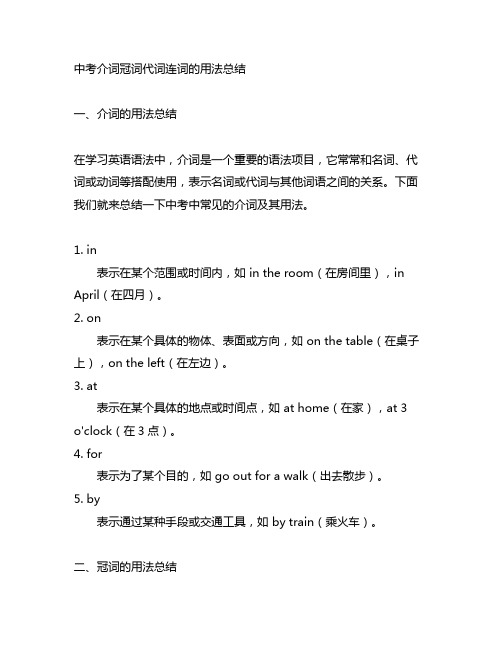
中考介词冠词代词连词的用法总结一、介词的用法总结在学习英语语法中,介词是一个重要的语法项目,它常常和名词、代词或动词等搭配使用,表示名词或代词与其他词语之间的关系。
下面我们就来总结一下中考中常见的介词及其用法。
1. in表示在某个范围或时间内,如 in the room(在房间里),in April(在四月)。
2. on表示在某个具体的物体、表面或方向,如 on the table(在桌子上),on the left(在左边)。
3. at表示在某个具体的地点或时间点,如 at home(在家),at 3 o'clock(在3点)。
4. for表示为了某个目的,如 go out for a walk(出去散步)。
5. by表示通过某种手段或交通工具,如 by train(乘火车)。
二、冠词的用法总结冠词是英语中一个比较难点的语法项目,分为定冠词“the”和不定冠词“a/an”。
下面我们来总结一下中考中常见的冠词用法。
1. 定冠词“the”表示特指,如 the sun(太阳)。
2. 不定冠词“a/an”表示泛指,如 a book(一本书)。
三、代词的用法总结代词是用来代替名词的词语,它能够减少重复,使语言更加简洁。
在中考中,代词也是一个重要的语法项目。
下面我们来总结一下中考中常见的代词及其用法。
1. 人称代词主格:I(我)、you(你)、he(他)、she(她)、it(它)、we(我们)、you(你们)、they(他们)。
宾格:me(我)、you(你)、him(他)、her(她)、it (它)、us(我们)、you(你们)、them(他们)。
形容词性:my/mine(我的)、your/yours(你的)、his(他的)、her/hers(她的)、its(它的)、our/ours(我们的)、your/yours(你们的)、their/theirs(他们的)。
2. 物主代词指代名词所有物,如 mine(我的)、yours(你的)、his(他的)、hers(她的)、its(它的)、ours(我们的)、yours(你们的)、theirs(他们的)。
英语之中名词代词动词形容词冠词数词副词介词连词感叹词

(一)1、名词名词 (Nouns)是词性的一种,也是实词的一种,是指待人、物、事、时、地、情感、概念等实体或抽象事物的词。
名词可以独立成句。
在短语或句子中通常可以用代词来替代。
2、代词是代替名词的一种词类。
大多数代词具有名词和形容词的功能。
英语中的代词,按其意义、特征及在句中的作用分为:人称代词、物主代词、指示代词、自身代词、相互代词、疑问代词、关系代词和不定代词八种。
3、动词,就是用来形容或表示各类动作的词汇。
基本上每个完整的子句都有一个动词,要表示第二个动作时可使用不定词、动名词、对等连接词、从属连接词或增加子句等方法连结。
根据其在句中的功能,动词可分为四类。
4、形容词形容词【adjective】很多语言中均有的主要词类中的一种。
主要用来修饰名词的词,表示事物的特征5、冠词的定义冠词是置于名词之前,对名词起限制作用的一种虚词。
冠词可以说是名词的一种标志,它不能离开名词而独立存在。
冠词的分类冠词分为不定冠词"a,an"、定冠词"the"和零冠词三种6、数词表示"多少"和"第几"的词,叫数词。
其用法相当于名词或者形容词。
数词分为基数词和序数词两种。
表示数目多少或顺序多少的词叫数词,数词分为基数词和序数词。
7、副词(Adverb)副词的定义: 副词是一种用来修饰动词,形容词,副词或全句的词,说明时间,地点,程度,方式等概念。
8、介词的定义和特征介词是一种用来表示词与词, 词与句之间的关系的词。
在句中不能单独作句字成分。
介词后面一般有名词代词或相当于名词的其他词类,短语或从句作它的宾语。
(二)1、名词,人或事物的名称3、代词,代替名词或者数词(比如some就是代替数目)3、动词,动作或状态4、数词,表示数目或顺序(比如序数词,5th就是表示顺序)5、形容词,人或事物的性质或状态(因为形容词一般修饰名词)6、副词,动作的特征或性状特征(因为副词一般修饰动词或形容词)7、冠词,表示名词的泛指或特指8、介词,表示名词或代词与其他词的关系(因为介词后面一半紧跟名词,代词或其他名词性结构)9、连词,连接词与词,短语与短语,句子与句子10、感叹词,表示说话时的感情或语气(三)1、adj. / a. 形容词用来描述一类物质的性质,状态,外貌,或人的性格特点,性质,品格如:big,happy2、adv. / ad. 副词用来修饰动作或形容词,一般在句子中做状语用表示动作的进行怎样,或表示程度,特点,如:clearly,happily3、prep. 介词连接地点,时间的一类词语,可以表示方位,时间.跟一些表示时间,地点的词连用表示介词词组如:in,to,on,under4、conj. 连词用来连接时间,地点,原因,结果的一类词语如:when,beacuse,so5、num. 数词表示数字的词,既可以是基数词,也可以是序数词如:one,two,first6、int. 感叹词表示感叹的一类词,一般不加一解释,只代表感叹如:what,how,haurray7、vt. 及物动词(后面要加宾语)行为动作的词如:do,finish,play8、vi. 不及物动词(后面不加宾语)表示行为动作的词如:appear9、n. 名词表示物体,物质的词如:pig,cow,man10、pron. 代词代指一类人,事或物的词如:he,she,hers,his,things11、art = 冠词,article的缩写(四)在英语语法中主要把词分为8大类:1.名词:表示人、物或地方等,如:John,teacher;table,pen;London;beauty.2.代词:用来代替名词,以避免重复某个名词,如:I,you,it,that,those,them.3.形容词:用来修饰或限制某个(些)名词,如:good(man),white(paper),every (book),much(water),(John is)hon-est,(He seems)lazy.被修饰或限制的名词,叫做主体词(head-word)。
英语之中名词、代词、动词、形容词、冠词、数词、副词、介词、连词、感叹词讲课讲稿
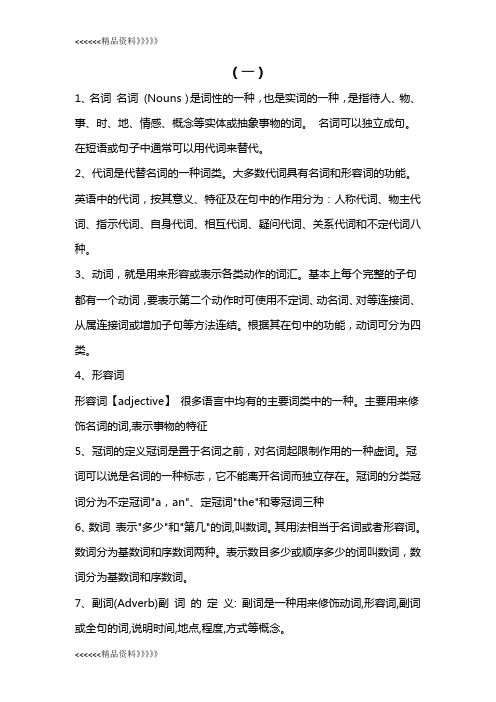
(一)1、名词名词(Nouns)是词性的一种,也是实词的一种,是指待人、物、事、时、地、情感、概念等实体或抽象事物的词。
名词可以独立成句。
在短语或句子中通常可以用代词来替代。
2、代词是代替名词的一种词类。
大多数代词具有名词和形容词的功能。
英语中的代词,按其意义、特征及在句中的作用分为:人称代词、物主代词、指示代词、自身代词、相互代词、疑问代词、关系代词和不定代词八种。
3、动词,就是用来形容或表示各类动作的词汇。
基本上每个完整的子句都有一个动词,要表示第二个动作时可使用不定词、动名词、对等连接词、从属连接词或增加子句等方法连结。
根据其在句中的功能,动词可分为四类。
4、形容词形容词【adjective】很多语言中均有的主要词类中的一种。
主要用来修饰名词的词,表示事物的特征5、冠词的定义冠词是置于名词之前,对名词起限制作用的一种虚词。
冠词可以说是名词的一种标志,它不能离开名词而独立存在。
冠词的分类冠词分为不定冠词"a,an"、定冠词"the"和零冠词三种6、数词表示"多少"和"第几"的词,叫数词。
其用法相当于名词或者形容词。
数词分为基数词和序数词两种。
表示数目多少或顺序多少的词叫数词,数词分为基数词和序数词。
7、副词(Adverb)副词的定义: 副词是一种用来修饰动词,形容词,副词或全句的词,说明时间,地点,程度,方式等概念。
8、介词的定义和特征介词是一种用来表示词与词, 词与句之间的关系的词。
在句中不能单独作句字成分。
介词后面一般有名词代词或相当于名词的其他词类,短语或从句作它的宾语。
(二)1、名词,人或事物的名称3、代词,代替名词或者数词(比如some就是代替数目)3、动词,动作或状态4、数词,表示数目或顺序(比如序数词,5th就是表示顺序)5、形容词,人或事物的性质或状态(因为形容词一般修饰名词)6、副词,动作的特征或性状特征(因为副词一般修饰动词或形容词)7、冠词,表示名词的泛指或特指8、介词,表示名词或代词与其他词的关系(因为介词后面一半紧跟名词,代词或其他名词性结构)9、连词,连接词与词,短语与短语,句子与句子10、感叹词,表示说话时的感情或语气(三)1、adj. / a. 形容词用来描述一类物质的性质,状态,外貌,或人的性格特点,性质,品格如:big,happy2、adv. / ad. 副词用来修饰动作或形容词,一般在句子中做状语用表示动作的进行怎样,或表示程度,特点,如:clearly,happily3、prep. 介词连接地点,时间的一类词语,可以表示方位,时间.跟一些表示时间,地点的词连用表示介词词组如:in,to,on,under4、conj. 连词用来连接时间,地点,原因,结果的一类词语如:when,beacuse,so5、num. 数词表示数字的词,既可以是基数词,也可以是序数词如:one,two,first6、int. 感叹词表示感叹的一类词,一般不加一解释,只代表感叹如:what,how,haurray7、vt. 及物动词(后面要加宾语)行为动作的词如:do,finish,play8、vi. 不及物动词(后面不加宾语)表示行为动作的词如:appear9、n. 名词表示物体,物质的词如:pig,cow,man10、pron. 代词代指一类人,事或物的词如:he,she,hers,his,things11、art = 冠词,article的缩写(四)在英语语法中主要把词分为8大类:1.名词:表示人、物或地方等,如:John,teacher;table,pen;London;beauty.2.代词:用来代替名词,以避免重复某个名词,如:I,you,it,that,those,them.3.形容词:用来修饰或限制某个(些)名词,如:good(man),white (paper),every(book),much(water),(John is)hon-est,(He seems)lazy.被修饰或限制的名词,叫做主体词(head-word)。
英语词性分类及用法和举例讲解
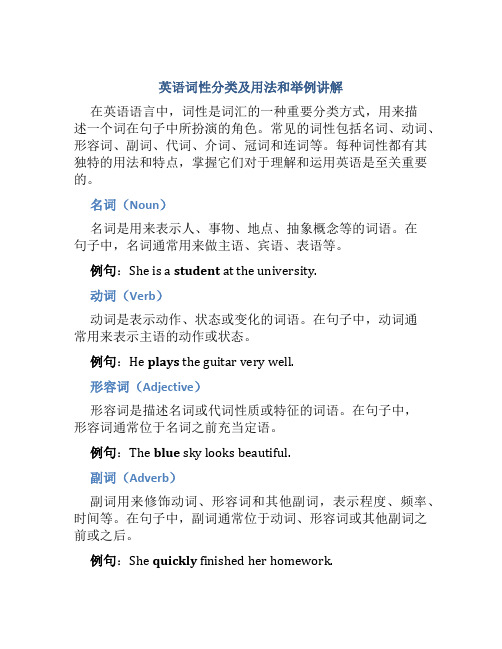
英语词性分类及用法和举例讲解在英语语言中,词性是词汇的一种重要分类方式,用来描述一个词在句子中所扮演的角色。
常见的词性包括名词、动词、形容词、副词、代词、介词、冠词和连词等。
每种词性都有其独特的用法和特点,掌握它们对于理解和运用英语是至关重要的。
名词(Noun)名词是用来表示人、事物、地点、抽象概念等的词语。
在句子中,名词通常用来做主语、宾语、表语等。
例句:She is a student at the university.动词(Verb)动词是表示动作、状态或变化的词语。
在句子中,动词通常用来表示主语的动作或状态。
例句:He plays the guitar very well.形容词(Adjective)形容词是描述名词或代词性质或特征的词语。
在句子中,形容词通常位于名词之前充当定语。
例句:The blue sky looks beautiful.副词(Adverb)副词用来修饰动词、形容词和其他副词,表示程度、频率、时间等。
在句子中,副词通常位于动词、形容词或其他副词之前或之后。
例句:She quickly finished her homework.代词(Pronoun)代词用来代替名词,避免重复使用名词。
常见的代词包括主格代词、宾格代词、物主代词等。
例句:He is my best friend.介词(Preposition)介词用于连接名词、代词或动词与其他词语,表示关系、方向、时间等。
介词通常位于名词或代词前面。
例句:She is at home now.冠词(Article)冠词用来限定名词,包括定冠词“the”和不定冠词“a”和“an”。
例句:I have a cat.连词(Conjunction)连词用来连接词语、短语或句子,使句子结构更加复杂和丰富。
常见的连词有并列连词、从属连词等。
例句:He is reading and writing.通过以上对英语词性分类及用法和举例讲解,我们可以更清晰地理解每种词性在句子中的作用和特点,从而更加准确地运用英语进行表达和沟通。
第三讲代词,介词,连词,冠词
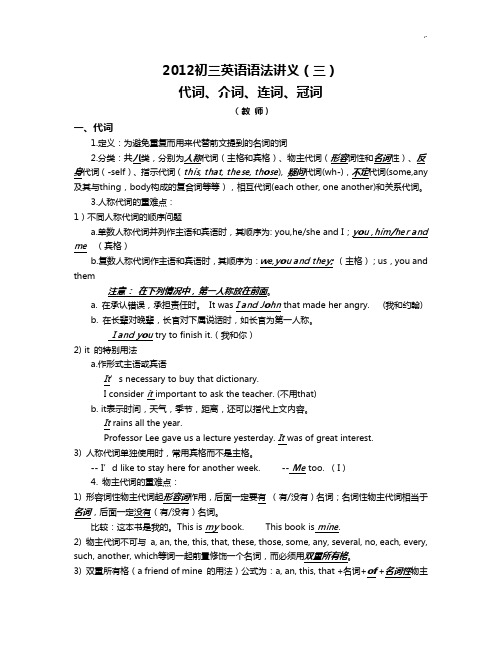
2012初三英语语法讲义(三)代词、介词、连词、冠词(教师)一、代词1.定义:为避免重复而用来代替前文提到的名词的词2.分类:共八类,分别为人称代词(主格和宾格)、物主代词(形容词性和名词性)、反身代词(-self)、指示代词(this, that, these, those), 疑问代词(wh-),不定代词(some,any 及其与thing,body构成的复合词等等),相互代词(each other, one another)和关系代词。
3.人称代词的重难点:1)不同人称代词的顺序问题a.单数人称代词并列作主语和宾语时,其顺序为: you,he/she and I;you ,him/her and me(宾格)b.复数人称代词作主语和宾语时,其顺序为:we,you and they;(主格);us,you and them注意:在下列情况中,第一人称放在前面。
a. 在承认错误,承担责任时。
It was I and John that made her angry. (我和约翰)b. 在长辈对晚辈,长官对下属说话时,如长官为第一人称。
I and you try to finish it.(我和你)2) it 的特别用法a.作形式主语或宾语It’s necessary to buy that dictionary.I consider it important to ask the teacher. (不用that)b. it表示时间,天气,季节,距离,还可以指代上文内容。
It rains all the year.Professor Lee gave us a lecture yesterday. It was of great interest.3) 人称代词单独使用时,常用宾格而不是主格。
-- I’d like to stay here for another week. -- Me too. (I)4. 物主代词的重难点:1) 形容词性物主代词起形容词作用,后面一定要有(有/没有)名词;名词性物主代词相当于名词,后面一定没有(有/没有)名词。
英语之中名词代词动词形容词冠词数词副词介词连词感叹词

(一)1、名词名词(Nouns)是词性的一种,也是实词的一种,是指待人、物、事、时、地、情感、概念等实体或抽象事物的词。
名词可以独立成句。
在短语或句子中通常可以用代词来替代。
2、代词是代替名词的一种词类。
大多数代词具有名词和形容词的功能。
英语中的代词,按其意义、特征及在句中的作用分为:人称代词、物主代词、指示代词、自身代词、相互代词、疑问代词、关系代词和不定代词八种。
3、动词,就是用来形容或表示各类动作的词汇。
基本上每个完整的子句都有一个动词,要表示第二个动作时可使用不定词、动名词、对等连接词、从属连接词或增加子句等方法连结。
根据其在句中的功能,动词可分为四类。
4、形容词形容词【adjective】很多语言中均有的主要词类中的一种。
主要用来修饰名词的词,表示事物的特征5、冠词的定义冠词是置于名词之前,对名词起限制作用的一种虚词。
冠词可以说是名词的一种标志,它不能离开名词而独立存在。
冠词的分类冠词分为不定冠词"a,an"、定冠词"the"和零冠词三种6、数词表示"多少"和"第几"的词,叫数词。
其用法相当于名词或者形容词。
数词分为基数词和序数词两种。
表示数目多少或顺序多少的词叫数词,数词分为基数词和序数词。
7、副词(Adverb)副词的定义: 副词是一种用来修饰动词,形容词,副词或全句的词,说明时间,地点,程度,方式等概念。
8、介词的定义和特征介词是一种用来表示词与词, 词与句之间的关系的词。
在句中不能单独作句字成分。
介词后面一般有名词代词或相当于名词的其他词类,短语或从句作它的宾语。
(二)1、名词,人或事物的名称3、代词,代替名词或者数词(比如some就是代替数目)3、动词,动作或状态4、数词,表示数目或顺序(比如序数词,5th就是表示顺序)5、形容词,人或事物的性质或状态(因为形容词一般修饰名词)6、副词,动作的特征或性状特征(因为副词一般修饰动词或形容词)7、冠词,表示名词的泛指或特指8、介词,表示名词或代词与其他词的关系(因为介词后面一半紧跟名词,代词或其他名词性结构)9、连词,连接词与词,短语与短语,句子与句子10、感叹词,表示说话时的感情或语气(三)1、adj. / a. 形容词用来描述一类物质的性质,状态,外貌,或人的性格特点,性质,品格如:big,happy2、adv. / ad. 副词用来修饰动作或形容词,一般在句子中做状语用表示动作的进行怎样,或表示程度,特点,如:clearly,happily3、prep. 介词连接地点,时间的一类词语,可以表示方位,时间.跟一些表示时间,地点的词连用表示介词词组如:in,to,on,under4、conj. 连词用来连接时间,地点,原因,结果的一类词语如:when,beacuse,so5、num. 数词表示数字的词,既可以是基数词,也可以是序数词如:one,two,first6、int. 感叹词表示感叹的一类词,一般不加一解释,只代表感叹如:what,how,haurray7、vt. 及物动词(后面要加宾语)行为动作的词如:do,finish,play8、vi. 不及物动词(后面不加宾语)表示行为动作的词如:appear9、n. 名词表示物体,物质的词如:pig,cow,man10、pron. 代词代指一类人,事或物的词如:he,she,hers,his,things11、art = 冠词,article的缩写(四)在英语语法中主要把词分为8大类:1.名词:表示人、物或地方等,如:John,teacher;table,pen;London;beauty.2.代词:用来代替名词,以避免重复某个名词,如:I,you,it,that,those,them.3.形容词:用来修饰或限制某个(些)名词,如:good(man),white (paper),every(book),much(water),(John is)hon-est,(He seems)lazy.被修饰或限制的名词,叫做主体词(head-word)。
高考英语语法填空介词、代词、连词、冠词和情态动词知识点汇总

④表示“关于”、“对于”cry over the silt milk
⑤表示“一面……,一面……”talk over a cup of tea
⑥表示“以上”、“超过”over and above, cost over £5
②表示“和”、“与”quarrel/argue with, go with, have nothing to do with
③表示“用”cut it with a knife, have no pen with which to write
④表示伴随状态walk with a stick, with no hat on
④表示理由、原因“因为”for fear of
⑤表示“代替,代表”substitute...for..., speak for
⑥表示“交换”(暗含一定的比例关系)translate word for word
⑦表示时间上、距离上,数量上的“历经……、多达……”for hours, last (for) one hour, run (for) a mile
⑦表示“关注”、“关照”look after, ask after you
above含义为“在……之上”,引申为“难于”、“所不及”、“超过”之意50 feet above sea level, above comprehension
under①表示“在……下”、“在……内部”、“在……脚下”under a tree, under a hill
分析:因these proverbs是名词,且不是作主,宾,表,前面很有可能填介词;句意是“在中国这些成语故事背后常常有有趣的故事”,表示“在......背后”,用介词behind。
英语之中名词代词动词形容词冠词数词副词介词连词感叹词

一1、名词名词Nouns是词性的一种,也是实词的一种,是指待人、物、事、时、地、情感、概念等实体或抽象事物的词; 名词可以独立成句;在短语或句子中通常可以用代词来替代;2、代词是代替名词的一种词类;大多数代词具有名词和形容词的功能;英语中的代词,按其意义、特征及在句中的作用分为:人称代词、物主代词、指示代词、自身代词、相互代词、疑问代词、关系代词和不定代词八种;3、动词,就是用来形容或表示各类动作的词汇;基本上每个完整的子句都有一个动词,要表示第二个动作时可使用不定词、动名词、对等连接词、从属连接词或增加子句等方法连结;根据其在句中的功能,动词可分为四类;4、形容词形容词adjective 很多语言中均有的主要词类中的一种;主要用来修饰名词的词,表示事物的特征5、冠词的定义冠词是置于名词之前,对名词起限制作用的一种虚词;冠词可以说是名词的一种标志,它不能离开名词而独立存在;冠词的分类冠词分为不定冠词"a,an"、定冠词"the"和零冠词三种6、数词表示"多少"和"第几"的词,叫数词;其用法相当于名词或者形容词;数词分为基数词和序数词两种;表示数目多少或顺序多少的词叫数词,数词分为基数词和序数词;7、副词Adverb副词的定义: 副词是一种用来修饰动词,形容词,副词或全句的词,说明时间,地点,程度,方式等概念;8、介词的定义和特征介词是一种用来表示词与词, 词与句之间的关系的词;在句中不能单独作句字成分;介词后面一般有名词代词或相当于名词的其他词类,短语或从句作它的宾语;二1、名词, 人或事物的名称3、代词, 代替名词或者数词比如some就是代替数目3、动词, 动作或状态4、数词, 表示数目或顺序比如序数词,5th就是表示顺序5、形容词,人或事物的性质或状态因为形容词一般修饰名词6、副词, 动作的特征或性状特征因为副词一般修饰动词或形容词7、冠词, 表示名词的泛指或特指8、介词, 表示名词或代词与其他词的关系因为介词后面一半紧跟名词,代词或其他名词性结构9、连词, 连接词与词,短语与短语,句子与句子10、感叹词, 表示说话时的感情或语气三1、adj. / a. 形容词用来描述一类物质的性质,状态,外貌,或人的性格特点,性质,品格如:big,happy2、adv. / ad. 副词用来修饰动作或形容词,一般在句子中做状语用表示动作的进行怎样,或表示程度,特点,如:clearly,happily3、prep. 介词连接地点,时间的一类词语,可以表示方位,时间.跟一些表示时间,地点的词连用表示介词词组如:in,to,on,under4、conj. 连词用来连接时间,地点,原因,结果的一类词语如:when,beacuse,so5、num. 数词表示数字的词,既可以是基数词,也可以是序数词如:one,two,first6、int. 感叹词表示感叹的一类词,一般不加一解释,只代表感叹如:what,how,haurray7、vt. 及物动词后面要加宾语行为动作的词如:do,finish,play8、vi. 不及物动词后面不加宾语表示行为动作的词如:appear9、n. 名词表示物体,物质的词如:pig,cow,man10、pron. 代词代指一类人,事或物的词如:he,she,hers,his,things11、art = 冠词,article的缩写四在英语语法中主要把词分为8大类:1.名词:表示人、物或地方等,如:John,teacher;table,pen;London;beauty.2.代词:用来代替名词,以避免重复某个名词,如:I,you,it,that,those,them.3.形容词:用来修饰或限制某个些名词,如:goodman,whitepaper,everybook,muchwater,John ishon-est,He seemslazy.被修饰或限制的名词,叫做主体词head-word;4.动词:表示行为或状态,如:speak,read,go,think,is,seem.5.介词:表示它后面的名词或代词跟它前面的动词、另一名词或形容词的关系;这些名词或代词称为介词的宾语;介词宾语和介词构成介词短语;He went to school.介词to把名词school和动词went联系起来He stood by me.He asked for it.The book on the desk is mine.介词on把名词book和另一名词desk 联系起来He lives in a house on the mountain.他住在山上的一幢房子里;The bridge across this river is built by a Frenchman.河上的桥是一位法国人修建的;He is sure of it.他对此很有把握;of联系it和sure.It is good for you.这对你有好处;He is angry with Mary.他生玛丽的气;6.副词:修饰或限制动词、形容词或其他副词,乃至介词、连词及整个句子;He walked slowly.他走得很慢;He did it carefully.他干得很仔细;He is a very kind man.他是一个非常善良的人;John is truly honest.约翰的确很诚实;He arrived too late.他到得太晚了;He walked rather slowly.他走得相当慢;He sat far behind me.他坐在我后面挺远的地方;He arrived exactly at seven.他在7点整到达;He will come probably after we take lunch.他可能在我们吃午饭之后到达;He loves her just because she is pretty.他爱她只是因为她漂亮; Luckily,he got back his money.幸好他把钱要回来了; Historically,China is a great nation.从历史上看中国是个伟大的国家; 7.连词:用来连接词、词组短语或句子,如:and,but,or,so;或把一个句子和一动词或名词联系起来,如:when,because,as,though,that.He visited Hong Kong and Singapore.连词and把Hong Kong和Singapore连接起来他访问了香港和新加坡;She is pretty but cruel.她很漂亮却很残忍;He does exercise in class or at home.他在课堂上或是在家里做练习;or 把in class和at home两个短语连接起来She sat by me,reading novels but turning her eyes tochildren about her from time to time.她坐在我身旁看小说,但不时把眼睛转向她周围的孩子们;He works hard,so he will succeed.他很努力,所以他会成功;so把he works hard和he will succeed连接起来He says this and that,but he does not mean them.他说这说那,但这些都不是他的真心话;He was writing when it was rainning.下雨时他正在写作;when把动词was raining和he was writing连接起来He became a beggar because he had been a gambler.他成了乞丐因为他爱赌博;He went to school though he was sick.他虽病了,但他仍然上学; The news that the enemy had surrendered soon reached us.不久传来了敌人投降的消息;8.感叹词:用来表示说话时的感情,如Oh,Alas,My上面只是对8大词类粗略的解释;另外冠词、数词也可算作两个词类,冠词只有a,an,the3个字,数词可归入形容词中;。
初中英语语法讲解及练习和答案

卷首寄语“没有语法不能很好地表达,而没有词汇则什么也不能表达。
”语言的学习是一个漫长又艰难的过程,而语法与语言能力之间的关系也是紧密关联的。
语法是语言的应用规则,虽然wilkins更加着眼于词汇,但对于母语为非英语语言的学生来讲,在学习英语的过程中系统地学习一些基础语法,是提高学生应用语言能力的一个有效途径。
对于目前国内中高考考生来讲,语法知识也是应试考核的一个重要项目,尤其是对于中考考生,语法项目的考核占有很大的卷面比例。
具体考核题型以单项选择、用所给词适当形式填空,句型转换为主。
兰州市06和07两届中考英语全卷为150分满分,其中均为单选20题(每题1分),所给词适当形式填空15题(每题1分),其中包括5分词汇考核,句型转换10题,(每题2分),这两卷直接语法考核就各占50分,为全卷总分的三分之一。
基于这样的考核模式,对于中考考生来讲,在整合应试能力的过程中,系统地学习语法知识,并进行大量的练习的必要性则是显而易见的了。
这本小册子针对初中学生的认知水平和语言解构能力,较通俗浅显地对大纲要求的语法项目和兰州市的命题模式进行了讲解和阐释,并附加了一部分习题,希望该册子对中考考生能有所助益。
Contents第一部分语法讲解第一讲词类、句子成分、构词法 (3)第二讲名词 (4)第三讲代词 (6)第四讲数词 (9)第五讲冠词 (10)第六讲形容词和副词 (12)第七讲介词 (19)第八讲动词(一)动词概述 (21)第九讲动词(二)动词时态和语态 (25)第十讲动词(三)非谓语动词及动词辨析 (29)第十一讲连词 (35)第十二讲简单句 (36)第十三讲句子成分 (39)第十四讲简单句句式 (42)第十五讲并列句和主从复合句 (43)第二部分巩固与提高测评测评一名词 (47)测评二代词 (48)测评三数词 (51)测评四冠词 (52)测评五形容词和副词 (54)测评六介词 (58)测评七动词 (60)测评八连词 (69)测评九句子 (70)测评十交际用语 (75)第三部分语法网络图第一讲:词类、句子成分和构词法:1、词类:英语词类分十种:名词、形容词、代词、数词、冠词、动词、副词、介词、连词、感叹词。
第三讲__英语代词的用法

第三讲__英语代词的用法Unit Three英语代词的用法定义与分类代词是代替名词及起名词作用的短语或句子的词。
代词根据其意思和用法可分为人称代词、物主代词、反身代词、指示代词、相互代词、疑问代词、连接代词、关系代词、不定代词九类。
人称代词,物主代词,反身代词用法概述这三种代词都有人称(一、二、三人称)的变化、数(单、复数)的变化,以及性(阴性、阳性、中性)的变化。
其中,人称代词除了这三种变化外,还有格(主格、宾格)的变化。
物主代词又包括两种形式:形容词性物主代词和名词性物主代词。
特别注意:形容词性物主代词its没有相应的名词性物主代词。
这三种代词的形式变化表如下:人称单复数主格宾格形容词性物主代词名词性物主代词反身代词第一人称单数I me my mine myself 复数we us our ours ourselves第二人称单数you you your yours yourself 复数you you your yours yourselves第三人称单数he him his his himselfshe her her hers herselfit it its 无itself复数they them their theirs themselvesI. 人称代词的用法1) 定义:人称代词是用来指代人、动物或事物的代词。
它必须在人称(第一人称、第二人称、及第三人称)、数(单数、复数)以及性(阴性、阳性、中性)三方面与被指代的名词一致。
如:I am a student. Tom is a boy, and he is a student.Mary is very pretty, and she likes singing.The boys are students, and they are in the room.The dog is small. It is Tom's.2)人称代词的句法功能A) 人称代词有主格和宾语之分:主格用作主语,宾格用作宾语。
初高中必学语法大全

高中英语语法大全学英语必看名词、形容词、代词、数词、冠词、动词、副词、介词、连词、感叹词。
1、名词(n.):表示人、事物、地点或抽象概念的名称。
如:boy, morning, bag, ball, class, orange.2、代词(pron.):主要用来代替名词。
如:who, she, you, it .3、形容词(adj..):表示人或事物的性质或特征。
如:good, right, white, orange .4、数词(num.):表示数目或事物的顺序。
如:one, two, three, first, second, third, fourth.5、动词(v.):表示动作或状态。
如:am, is,are,have,see .6、副词(adv.):修饰动词、形容词或其他副词,说明时间、地点、程度等。
如:now, very, here, often, quietly, slowly.7、冠词(art..):用在名词前,帮助说明名词。
如:a, an, the.8、介词(prep.):表示它后面的名词或代词与其他句子成分的关系。
如in, on, from, above, behind.9、连词(conj.):用来连接词、短语或句子。
如and, but, before .10、感叹词(interj..)表示喜、怒、哀、乐等感情。
如:oh, well, hi, hello.2、句子成分:英语句子成分分为七种:主语、谓语、宾语、定语、状语、表语、宾语补足语。
1、主语是句子所要说的人或事物,回答是“谁”或者“什么”。
通常用名词或代词担任。
如:I’m Miss Green.(我是格林小姐)2、谓语动词说明主语的动作或状态,回答“做(什么)”。
主要由动词担任。
如:Jack cleans the room every day. (杰克每天打扫房间)3、表语在系动词之后,说明主语的身份或特征,回答是“什么”或者“怎么样”。
英语之中名词代词动词形容词冠词数词副词介词连词感叹词

(一)1、名词名词(Nouns)是词性的一种,也是实词的一种,是指待人、物、事、时、地、情感、概念等实体或抽象事物的词。
名词可以独立成句。
在短语或句子中通常可以用代词来替代。
2、代词是代替名词的一种词类。
大多数代词具有名词和形容词的功能。
英语中的代词,按其意义、特征及在句中的作用分为:人称代词、物主代词、指示代词、自身代词、相互代词、疑问代词、关系代词和不定代词八种。
3、动词,就是用来形容或表示各类动作的词汇。
基本上每个完整的子句都有一个动词,要表示第二个动作时可使用不定词、动名词、对等连接词、从属连接词或增加子句等方法连结。
根据其在句中的功能,动词可分为四类。
4、形容词形容词【adjective】很多语言中均有的主要词类中的一种。
主要用来修饰名词的词,表示事物的特征5、冠词的定义冠词是置于名词之前,对名词起限制作用的一种虚词。
冠词可以说是名词的一种标志,它不能离开名词而独立存在。
冠词的分类冠词分为不定冠词"a,an"、定冠词"the"和零冠词三种6、数词表示"多少"和"第几"的词,叫数词。
其用法相当于名词或者形容词。
数词分为基数词和序数词两种。
表示数目多少或顺序多少的词叫数词,数词分为基数词和序数词。
7、副词(Adverb)副词的定义: 副词是一种用来修饰动词,形容词,副词或全句的词,说明时间,地点,程度,方式等概念。
8、介词的定义和特征介词是一种用来表示词与词, 词与句之间的关系的词。
在句中不能单独作句字成分。
介词后面一般有名词代词或相当于名词的其他词类,短语或从句作它的宾语。
(二)1、名词,人或事物的名称3、代词,代替名词或者数词(比如some就是代替数目)3、动词,动作或状态4、数词,表示数目或顺序(比如序数词,5th就是表示顺序)5、形容词,人或事物的性质或状态(因为形容词一般修饰名词)6、副词,动作的特征或性状特征(因为副词一般修饰动词或形容词)7、冠词,表示名词的泛指或特指8、介词,表示名词或代词与其他词的关系(因为介词后面一半紧跟名词,代词或其他名词性结构)9、连词,连接词与词,短语与短语,句子与句子10、感叹词,表示说话时的感情或语气(三)1、adj. / a. 形容词用来描述一类物质的性质,状态,外貌,或人的性格特点,性质,品格如:big,happy2、adv. / ad. 副词用来修饰动作或形容词,一般在句子中做状语用表示动作的进行怎样,或表示程度,特点,如:clearly,happily3、prep. 介词连接地点,时间的一类词语,可以表示方位,时间.跟一些表示时间,地点的词连用表示介词词组如:in,to,on,under4、conj. 连词用来连接时间,地点,原因,结果的一类词语如:when,beacuse,so5、num. 数词表示数字的词,既可以是基数词,也可以是序数词如:one,two,first6、int. 感叹词表示感叹的一类词,一般不加一解释,只代表感叹如:what,how,haurray7、vt. 及物动词(后面要加宾语)行为动作的词如:do,finish,play8、vi. 不及物动词(后面不加宾语)表示行为动作的词如:appear9、n. 名词表示物体,物质的词如:pig,cow,man10、pron. 代词代指一类人,事或物的词如:he,she,hers,his,things11、art = 冠词,article的缩写(四)在英语语法中主要把词分为8大类:1.名词:表示人、物或地方等,如:John,teacher;table,pen;London;beauty.2.代词:用来代替名词,以避免重复某个名词,如:I,you,it,that,those,them.3.形容词:用来修饰或限制某个(些)名词,如:good(man),white (paper),every(book),much(water),(John is)hon-est,(He seems)lazy.被修饰或限制的名词,叫做主体词(head-word)。
什么叫介词, 副词 ,定冠词 ,助动词 ,代词……
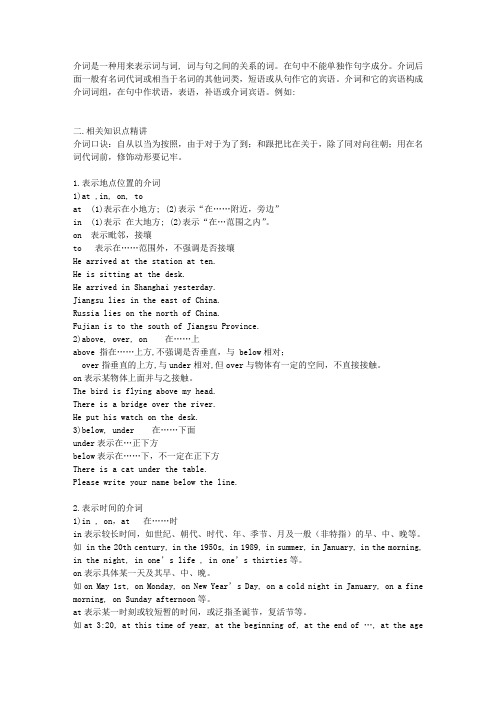
介词是一种用来表示词与词, 词与句之间的关系的词。
在句中不能单独作句字成分。
介词后面一般有名词代词或相当于名词的其他词类,短语或从句作它的宾语。
介词和它的宾语构成介词词组,在句中作状语,表语,补语或介词宾语。
例如:二.相关知识点精讲介词口诀:自从以当为按照,由于对于为了到;和跟把比在关于,除了同对向往朝;用在名词代词前,修饰动形要记牢。
1.表示地点位置的介词1)at ,in, on, toat (1)表示在小地方; (2)表示“在……附近,旁边”in (1)表示在大地方; (2)表示“在…范围之内”。
on 表示毗邻,接壤to 表示在……范围外,不强调是否接壤He arrived at the station at ten.He is sitting at the desk.He arrived in Shanghai yesterday.Jiangsu lies in the east of China.Russia lies on the north of China.Fujian is to the south of Jiangsu Province.2)above, over, on 在……上above 指在……上方,不强调是否垂直,与 below相对;over指垂直的上方,与under相对,但over与物体有一定的空间,不直接接触。
on表示某物体上面并与之接触。
The bird is flying above my head.There is a bridge over the river.He put his watch on the desk.3)below, under 在……下面under表示在…正下方below表示在……下,不一定在正下方There is a cat under the table.Please write your name below the line.2.表示时间的介词1)in , on,at 在……时in表示较长时间,如世纪、朝代、时代、年、季节、月及一般(非特指)的早、中、晚等。
英语之中名词、代词、动词、形容词、冠词、数词、副词、介词、连词、感叹词
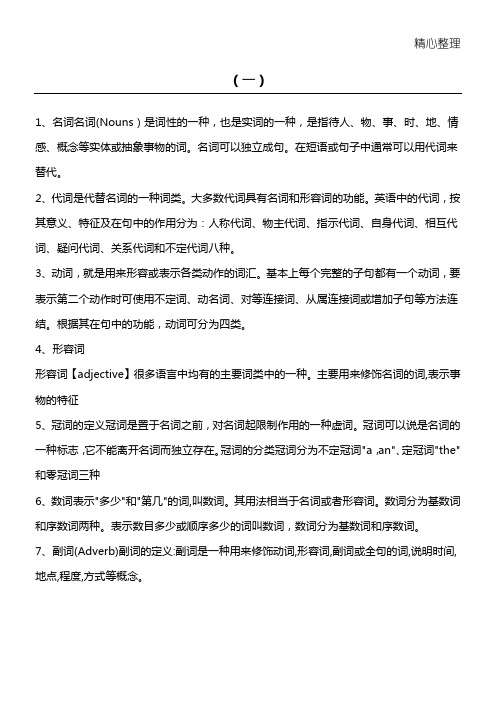
5.介词:表示它后面的名词(或代词)跟它前面的动词、另一名词或形容词的关系。这些名词(或代词)称为介词的宾语。
介词宾语和介词构成介词短语。
Hewenttoschool.(介词to把名词school和动词went联系起来)
Heisaverykindman.他是一个非常善良的人。
Johnistrulyhonest.约翰的确很诚实。
Hearrivedtoolate.他到得太晚了。
Hewalkedratherslowly.他走得相当慢。
Hesatfarbehindme.他坐在我后面挺远的地方。
Hearrivedexactlyatseven.他在7点整到达。
Sheisprettybutcruel.她很漂亮却很残忍。
Hedoesexerciseinclassorathome.他在课堂上或是在家里做练习。(or把inclass和athome两个短语连接起来)
Shesatbyme,readingnovelsbutturninghereyestochildrenaboutherfromtimetotime.她坐在我身旁看小说,但不时把眼睛转向她周围的孩子们。
2.代词:用来代替名词,以避免重复某个名词,如:I,you,it,that,those,them.
3.形容词:用来修饰或限制某个(些)名词,如:good(man),white(paper),every(book),much(water),(Johnis)hon-est,(Heseems)lazy.被修饰或限制的名词,叫做主体词(head-word)。
5、冠词的定义冠词是置于名词之前,对名词起限制作用的一种虚词。冠词可以说是名词的一种标志,它不能离开名词而独立存在。冠词的分类冠词分为不定冠词"a,an"、定冠词"the"和零冠词三种
英语之中名词、代词、动词、形容词、冠词、数词、副词、介词、连词、感叹词

英语之中名词、代词、动词、形容词、冠词、数词、副词、介词、连词、感叹词副词用来修饰动词、形容词或其他副词,表示时间、地点、方式、程度等概念。
如: slowly。
here3、___名词表示人、物、地点、时间、情感、概念等实体或抽象事物的词汇。
可独立成句,通常可以用代词替代。
如: book。
love4、___代词代替名词或数词的一种词类,具有名词和形容词的功能。
包括人称代词、物主代词、指示代词、自身代词、相互代词、疑问代词、关系代词和不定代词。
如: he。
their。
this5、v。
/ verb动词用来表示动作或状态的词汇,每个完整的子句都要有一个动词。
可使用不定词、动名词、对等连接词、从属连接词或增加子句等方法连结。
如: run。
think6、___数词表示数目或顺序的词汇,可用作名词或形容词。
分为基数词和序数词两种。
如: three。
fifth7、art。
/ article冠词置于名词前起限制作用的一种虚词,分为不定冠词"a,an"、定冠词"the"和零冠词。
如: a book。
the sky8、___介词用来表示词与词、词与句之间的关系的词汇,不能单独作句子成分。
后面一般有名词代词或相当于名词的其他词类、短语或从句作宾语。
如: in。
with9、___连词用来连接词与词、短语与短语、句子与句子的词汇。
如: and。
but10、int。
/ n感叹词表示说话时的感情或语气的词汇。
如: wow。
oh___ for you。
He is upset with Mary。
Adverbs modify or limit verbs。
adjectives。
other adverbs。
and even ns。
ns。
___ the task with great care。
He is an ___ kind individual。
John is ___ at seven o'clock。
图说英语表解语法:冠词,连词,介词

图说英语:冠词,连词,介词
冠词
英语中有a,an,和the这三个冠词, a/an为不定冠词, the是定冠词。
有时名词前不用冠词称为零冠词。
冠词是一种虚词, 不能单独作句子成分, 只能放在名词前面, 帮助说明这个名词的含义。
一、冠词的类别和最基本用法
二、不定冠词的使用场合
定冠词的使用场合
三、
四、不用冠词(零冠词)的情况
五、冠词的位置
六、差之一冠, 意差千里
有些词组中, 有无冠词, 意义相处很多, 甚至相反, 常见的词组有:
连词
连词是连接单词短语或句子的一种虚词, 在句子中不单独作句子成分,一般不重读,按照性质分并列连词和从属连词.
一、连词的分类及使用
二、几组常用连词的比较
三、几组较为特殊的连词:
第五章介词
介词是一种虚词, 不能重读, 也不能单独作句子成分, 通常用于名词或相当于名词的词及代词前, 表示其后的词语与句中其他词之间的关系。
介词和名词或代词构成介词短语。
介词短语才能作句子成分。
介词后面的名词或代词称为介词的宾语, 其后的代词需用宾格。
一、介词的分类
二、介词宾语的类型
三、介词短语的句法功能
四、介词和其他词类的搭配
五、易混用的介词短语
六、介词的省略。
- 1、下载文档前请自行甄别文档内容的完整性,平台不提供额外的编辑、内容补充、找答案等附加服务。
- 2、"仅部分预览"的文档,不可在线预览部分如存在完整性等问题,可反馈申请退款(可完整预览的文档不适用该条件!)。
- 3、如文档侵犯您的权益,请联系客服反馈,我们会尽快为您处理(人工客服工作时间:9:00-18:30)。
2012初三英语语法讲义(三)代词、介词、连词、冠词(教师)一、代词1.定义:为避免重复而用来代替前文提到的名词的词2.分类:共八类,分别为人称代词(主格和宾格)、物主代词(形容词性和名词性)、反身代词(-self)、指示代词(this, that, these, those), 疑问代词(wh-),不定代词(some,any及其与thing,body构成的复合词等等),相互代词(each other, one another)和关系代词。
3.人称代词的重难点:1)不同人称代词的顺序问题a.单数人称代词并列作主语和宾语时,其顺序为: you,he/she and I;you ,him/her and me(宾格)b.复数人称代词作主语和宾语时,其顺序为:we,you and they;(主格);us,you and them注意:在下列情况中,第一人称放在前面。
a. 在承认错误,承担责任时。
It was I and John that made her angry.(我和约翰)b. 在长辈对晚辈,长官对下属说话时,如长官为第一人称。
I and you try to finish it.(我和你)2) it 的特别用法a.作形式主语或宾语It’s necessary to buy that dictionary.I consider it important to ask the teacher. (不用that)b. it表示时间,天气,季节,距离,还可以指代上文内容。
It rains all the year.Professor Lee gave us a lecture yesterday. It was of great interest.3) 人称代词单独使用时,常用宾格而不是主格。
-- I’d like to stay here for another week. -- Me too. (I)4. 物主代词的重难点:1) 形容词性物主代词起形容词作用,后面一定要有(有/没有)名词;名词性物主代词相当于名词,后面一定没有(有/没有)名词。
比较:这本书是我的。
This is my book. This book is mine.2) 物主代词不可与a, an, the, this, that, these, those, some, any, several, no, each, every, such, another, which等词一起前置修饰一个名词,而必须用双重所有格。
3) 双重所有格(a friend of mine 的用法)公式为:a, an, this, that +名词+of +名词性物主代词e.g. How many friends of yours(你的多少朋友)will come to the party?5. 反身代词的重难点:1) 可作宾语、同位语、表语等,但不能单独作主语。
判断正误: Myself drive the car. (F)I myself drive the car. (T)2) 当宾语代词与主语指同一人时,宾语要用反身代词。
You should be proud of yourself. (you)比较: Mary saw herself in the mirror. (she)(看到她自己)Mary saw her in the mirror. (she)(看到另外一人)3) oneself亲自(做),相当于personally, in person;by oneself独自(做),相当于alone或独立做;for oneself 独立(做…),自己动手做,相当于without being helped或者“为自己”b. You should go to see him yourself. (you) 你应该亲自去见他。
He likes to take a walk by himself. (he) 他喜欢独自一人去散步。
You should work out problem for yourself. (you) 你应该独立解决这个问题。
4) teach oneself 自学enjoy oneself 过得愉快dress oneself 自己穿衣服can’t help oneself情不自禁help oneself to 随便吃/请自便talk / speak to oneself 自言自语6.指示代词的重难点:1)this, these常指时间,空间离说话者较近人或物;that,those常指时间,空间离说话者较远人或物。
2) that, those用来代替前面说过的事物以免重复。
The weather in Wuhan is much colder than that in Guangzhou in winter. (用this/that填空)The radios made in Guangzhou are better than those made in Changchun.3) that有时可代替句子或句中的一部分。
He was ill. That’s why he didn’t come.7.疑问代词 who/whomWho put the light out before I finished my work?Whom/ who have you chosen to take part in the sports meeting?With whom did you go to the concert?8.不定代词的重难点:1) 包括all, both, each, either, neither, more, little, few, much, many, *another, *other, others, some, any, *every, *no, one以及something, anything, everything, somebody, someone, anybody, anyone, nothing , nobody, no one, none, everybody, everyone.2) 以上既可起名词作用也可用作形容词,但标*的除外,他们只能作定语;“以及”后面的只能起名词作用。
3) all VS both: all指三者及三者以上; both指两者。
a. all的主谓一致:all的单复数由它所修饰或指代的名词的单复数决定。
All goes (go) well.All of the students come (come).b. bothBoth Mary and Mike are students. (beWe both can speak English. (speak)We are both students. 位置在名词前,行为动词前,be动词之后。
(前/后)4) either VS neither: either指两者中任意一个; neither指两者中没有一个,全否定。
a.作主语时,谓语动词多用单数,但有时复数也可以。
Either of the films is/are good. Neither of the films is/are good.b.作定语与单数名词连用。
Either film is good. Neither film is good.c.可用于下列句型,避免重复。
She can't sing,neither (can) he.5) neither VS nora.如不同的人不做同一件事用neither。
e.g. If you don't do it,neither should I.(neither/nor)b.如同一个人不做不同的事用nor,不用neither。
e.g. He can't sing,nor dance,nor skate.6) no one VS none:No one一般指人,其后不能加of短语;none既可指人也可指物,其后能加of短语。
No one 常用来回答who的提问;none常用来回答how many/ much的提问。
①-- Who told you the news? -- No one. I read the newspaper. (no one/ none)②--How much money have you got on you? -- None.a. none of表示若干人(物)中一个也不,谓语动词可单可复。
b.在答语中none可单独使用。
e.g. ---Are there any pictures on the wall?---None.7) one VS that VS it: one表示泛指与前面的名词同类的另一事物,既‘同名异物’;that, it表示特指。
that与所指名词为同类,但不是同一个,而it 与所指名词为同一个。
e.g. I can't find my hat. I think I must buy one.(不定) (one/ that/ it)The hat you bought is bigger than that I bought.(同类但不同个)I can't find my hat. I don' t know where I put it.(同一物)8) some VS anya. some也可与单数名词连用,意为"某一"(= a certain)e.g. You will be sorry for this some day.b. any可用于肯定句,含有任何的意思e.g. Here are three novels. You may read any.c. some用于肯定疑问句中:说话人认为对方的答案会是肯定的,或期望得到肯定回答时。
Would you like句式中,表委婉请求或建议,如:Would you like some coffee?9) one/ another/ the other / others:one… the other只有两个some… the others有三个以上others = other people/things; the others = the rest剩余的全部another泛指另一个a.一定范围内两人(物),一个用one,另一个用the other。
b.一定范围内三者,一个用one,另一个用one (another),第三个可用the other,a third。
